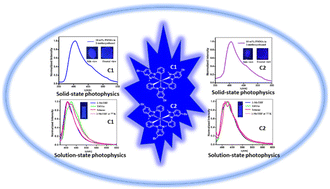Effect of substitution on deep-blue Ir(iii) N-heterocyclic carbene (NHC) emitters†
Abstract
The development of Ir(III)-NHC phosphors that display deep-blue luminescence without sacrificing the high photoluminescence quantum yield (PLQY) has become a pivotal area of research. In this respect, two novel deep-blue Ir-NHC emitters (C1 and C2) with strategically designed pro-carbenic imidazolium ligands (L1 and L2) incorporating a heavy bromine atom at the ligand-scaffold were synthesized in good yields (∼80% for L1, L2 and 65% for C1, C2). The ground and excited state properties of the complexes were photophysically determined and the results were found to be in accordance with theoretical calculations at the DFT and TD-DFT levels. Due to the strong σ-donation of the carbene ligands, complexes C1 and C2 displayed oxidation at low anodic potentials. Both the complexes showed deep-blue emission either in solution (λem ∼ 400–425 nm) or as PMMA-doped films of varying concentrations (λem ∼ 400 nm) with an ∼15 times enhanced PLQY with respect to benchmark Ir-NHC complexes. The strategy of incorporating the heavy bromine atom to reduce the molecular vibrations in C1 and C2 was further supported by ∼250 times reduced non-radiative decay constants (knr) and Huang–Rhys constants of C1 and C2 in comparison to those of the benchmark complexes. These facts were also supported by triplet frequency calculations of C1 and C2 to identify the absence of vibrations.

- This article is part of the themed collection: New Talent: Asia Pacific


 Please wait while we load your content...
Please wait while we load your content...